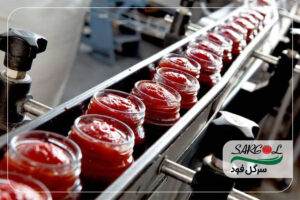Production stages of tomato paste in the factory
The production of tomato paste in a factory is a complex and multi-step process that requires precision and the use of advanced equipment. Here is a detailed explanation of the stages involved in producing tomato paste:

1. Selection and Procurement of Raw Materials (Tomatoes):
- Factories source tomatoes from farms. The tomatoes must be of a variety suitable for paste production, particularly those that are red, flavorful, and have adequate sugar content. The quality of the tomatoes directly affects the quality of the paste.
2. Washing:
- Upon arrival at the factory, the tomatoes are cleaned of any surface contaminants such as dirt, leaves, and plant residues. This is done using specialized washing machines that spray water at high pressure. Some factories use multi-stage washing systems to ensure thorough cleaning.
3. Sorting (Grading):
- At this stage, tomatoes are sorted by quality and size. Damaged, overripe, or otherwise unsuitable tomatoes are removed from the production line. Sorting can be done manually or with automatic sorting machines. Suitable tomatoes are then directed to the main production line.

4. Crushing:
- The tomatoes are directed to crushing machines. In these machines, the tomatoes are broken down into smaller pieces to facilitate further processing. This step increases the surface area of the tomatoes, making them easier to process in subsequent stages.
5. Preheating:
- The crushed tomatoes are transferred to preheating tanks. In this stage, the tomatoes are heated to a temperature between 85°C and 100°C for a short time. This softens the tomatoes and makes it easier to separate the skin and seeds later on. Preheating also reduces the microbial load and increases the shelf life of the final product.
6. Pulp Extraction:
- The heated tomato mixture is fed into pulping machines. These machines typically consist of several cylinders and filters that separate the tomato pulp from the skin, seeds, and other solid particles. The result is a smooth, homogeneous tomato pulp that includes both the juice and the solid parts of the tomatoes.
7. Concentration (Evaporation):
- The tomato pulp is transferred to evaporators. In these machines, water is removed from the pulp through heating, increasing the concentration of the solids (i.e., the tomato paste). These machines can operate continuously or in batches, with the concentration typically being adjusted to a Brix level (soluble solids content) of 28% to 30% for standard tomato paste.
8. Adding Salt and Preservatives:
- After concentration, salt is added to the paste to enhance its flavor and extend its shelf life. Some factories may also add natural or artificial preservatives, although this step depends on the manufacturer’s policies and market requirements. Many large producers prefer to avoid chemical additives and use natural methods to increase shelf life.
9. Packaging:
- The concentrated tomato paste is directed to packaging machines. The packaging can be in the form of metal cans, glass jars, or plastic pouches. Before packaging, the containers are sterilized to prevent microbial contamination.
10. Sterilization:
- The filled packages are then subjected to sterilization. During this process, the packages are exposed to high temperatures (between 110°C and 120°C) to kill any remaining microbes or bacteria in the paste or inside the containers. This ensures that the tomato paste remains safe for consumption over a longer period.
11. Cooling:
- After sterilization, the packages are quickly cooled to prevent damage to the packaging and to maintain the quality of the product. Cooling is usually done with cold water or cold air flow.

12. Labeling and Final Packaging:
- The sterilized packages are sent to the labeling section, where product information, such as brand name, production date, expiration date, and ingredients, is printed on the packages. The packages are then placed in larger boxes and prepared for distribution to the market.
13. Quality Control:
- Throughout all stages, the factory’s quality control team monitors each step to ensure the final product meets the desired quality standards. This includes chemical, microbiological, and sensory tests.
14. Distribution and Storage:
- After production and packaging are complete, the tomato paste is transferred to specialized warehouses and then distributed to the market. During this stage, storage conditions, such as temperature and humidity, are controlled to ensure the product reaches consumers in optimal condition.
These stages are carried out with precision and optimization to produce a high-quality final product that meets health standards and is ready for market distribution.







